headlight MAZDA MODEL CX-5 2017 - RHD (UK, Australia) (in English) Owner's Guide
[x] Cancel search | Manufacturer: MAZDA, Model Year: 2017, Model line: MODEL CX-5, Model: MAZDA MODEL CX-5 2017Pages: 772, PDF Size: 19.35 MB
Page 268 of 772
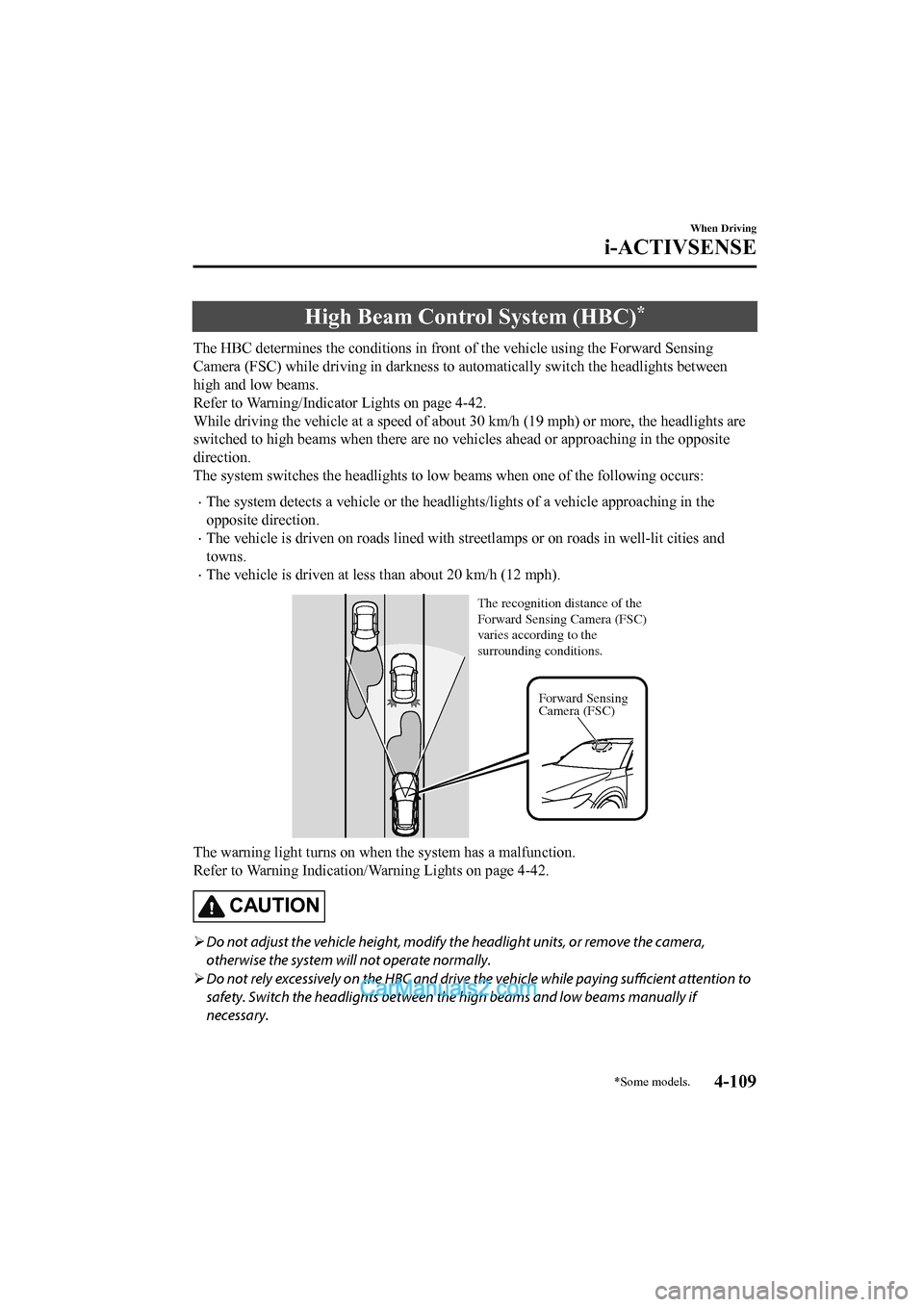
High Beam Control System (HBC)*
The HBC determines the conditions in front of the vehicle using the Forward Sensing
Camera (FSC) while driving in darkness to automatically switch the headlights between
high and low beams.
Refer to Warning/Indicator Lights on page 4-42.
While driving the vehicle at a speed of about 30 km/h (19 mph) or more, the headlights are
switched to high beams when there are no vehicles ahead or appr oaching in the opposite
direction.
The system switches the headlights to low beams when one of the following occurs:
â¢The system detects a vehicle or the headlights/lights of a vehicle approaching in the
opposite direction.
â¢The vehicle is driven on roads lin ed with streetlamps or on roads in well-lit cities and
towns.
â¢The vehicle is driven at less than about 20 km/h (12 mph).
Forward Sensing
Camera (FSC)
The recognition distance of the
Forward Sensing Camera (FSC)
varies according to the
surrounding conditions.
The warning light turns on when the system has a malfunction.
Refer to Warning Indication/Warning Lights on page 4-42.
CAUTION
ï
Do not adjust the vehicle he ight, modify the headlight units, or remove the camera,
otherwise the system will not operate normally.
ï Do not rely excessively on the HBC and drive the vehicle while paying
sufficient attention to
safety. Switch the headlights between th e high beams and low beams manually if
necessary.
When Driving
i-ACTIVSENSE
*Some models.4-109
2017-6-7 7:51:19 Form No. CX-5 8FY4-EE-17E+L_Edition2
Page 269 of 772

NOTE
The timing in which the system switches the headlights changes under the following
conditions. If the system does not switch the headlights appropriately, manually switch
between high and low beams according to the visibility as well as road and traffic
conditions.
â¢When there are sources of light in the area such as street lamps, illuminated signboards,
and traffic signals.
â¢When there are reflective objects in the surrounding area such as reflective plates and
signs.
â¢When visibility is reduced under rain, snow and foggy conditions.
â¢When driving on roads with sharp turn or hilly terrain.
â¢When the headlights/rear lamps of vehicles in front of you or in the opposite lane are dim
or not illuminated.
â¢When there is insufficient darkness such as at dawn or dusk.
â¢When the luggage compartment is loaded with heavy objects or the rear passenger seats
are occupied.
â¢When visibility is reduced due to a vehicle in front of you spraying water from its tyres
onto your windscreen.
â¼ To Operate the System
The HBC operates to sw
itch the headlights
automatically between high and low
beams after the ignition is switched ON
and the headlight switch is in the AUTO
and high beam position.
The HBC determines t hat it is dark based
on the brightness of the surrounding area.
At the same time, th e HBC indicator light
(green) in the instrument cluster
illuminates.
The HBC determines t hat it is dark based
on the brightness of the surrounding area.
NOTE
â¢When the vehicle speed is about 30 km/h
(19 mph) or more, the headlights
automatically switch to high beams
when there are no vehicles ahead or
approaching in the opposite direction.
When the vehicle speed is less than
about 20 km/h (12 mph), the HBC
switches the headlights to low beams.
â¢The low beams may not switch to high
beams when cornering.
â¢Operation of the HBC function can be
disabled. Refer to Personalisation
Features on page 9-12.
When Driving
i-ACTIVSENSE
4-110
2017-6-7 7:51:19 Form No. CX-5 8FY4-EE-17E+L_Edition2
Page 270 of 772
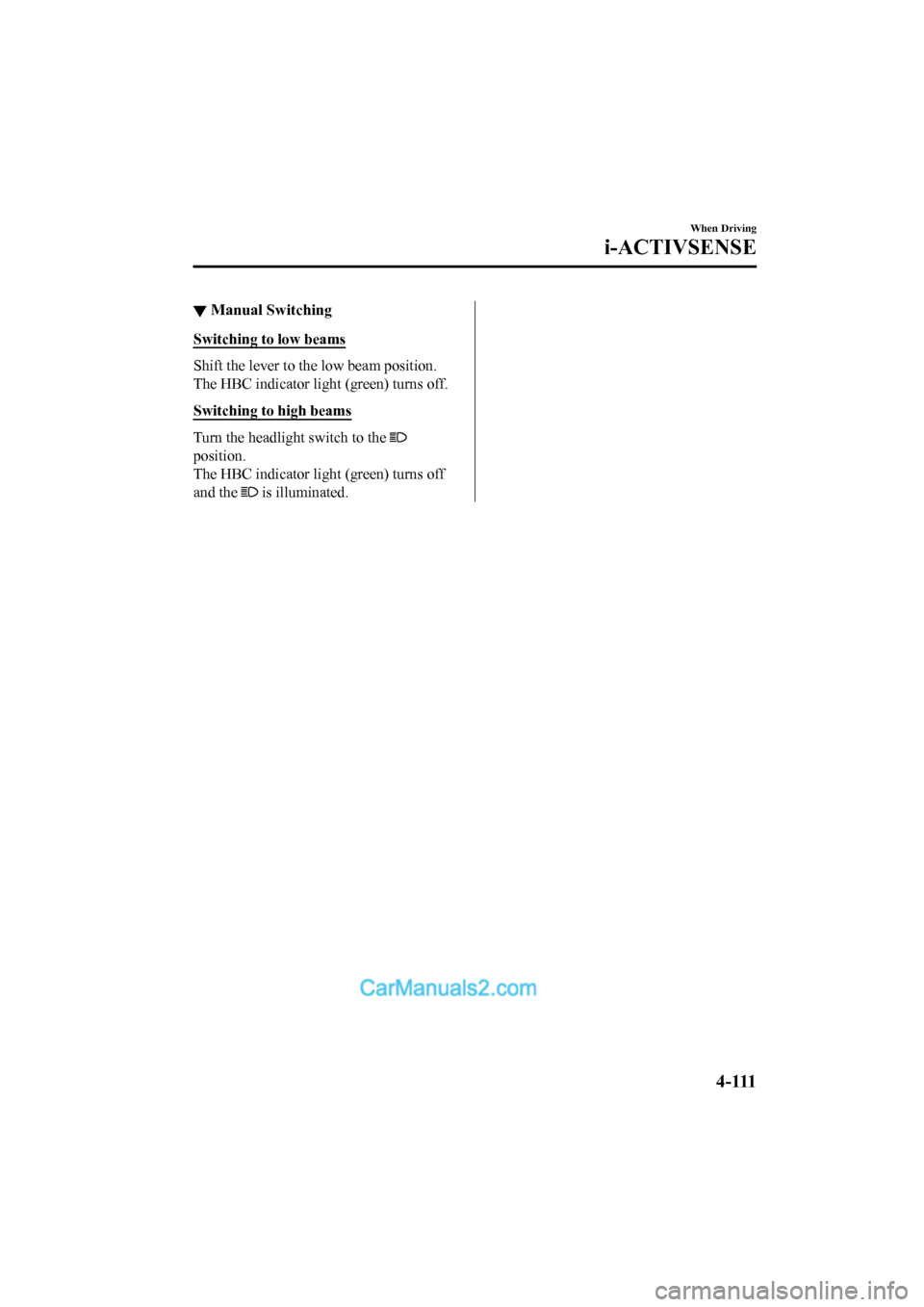
â¼Manual Switching
Switching to
low beams
Shift the lever to the low beam position.
The HBC indicator light (green) turns off.
Switching to high beams
Turn the headlight switch to the
position.
The HBC indicator light (green) turns off
and the
is illuminated.
When Driving
i-ACTIVSENSE
4 - 111
2017-6-7 7:51:19 Form No. CX-5 8FY4-EE-17E+L_Edition2
Page 271 of 772
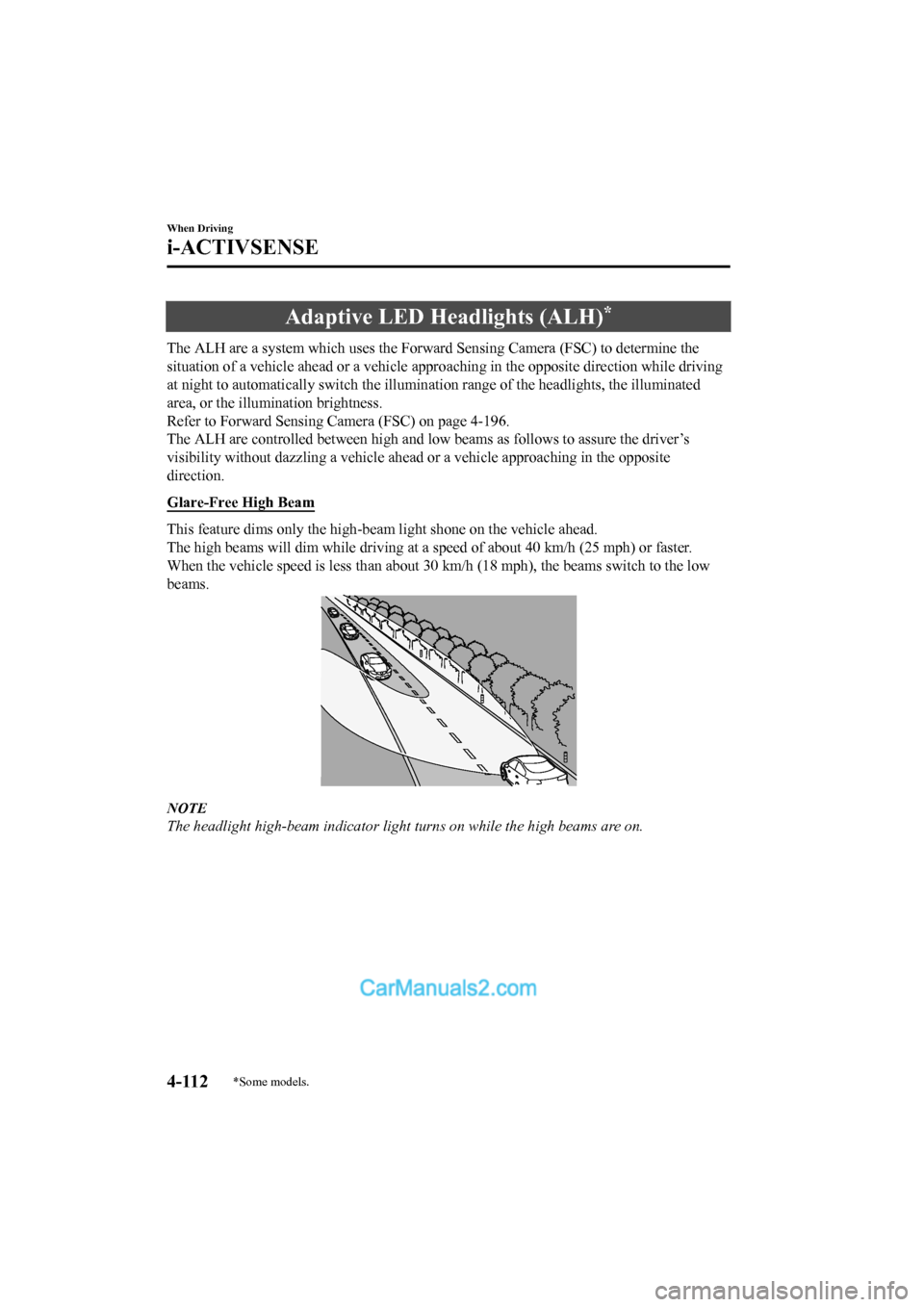
Adaptive LED Headlights (ALH)*
The ALH are a system which uses the Forward Sensing Camera (FSC) to determine the
situation of a vehicle ahead or a vehicle approaching in the op posite direction while driving
at night to automatically switc h the illumination range of the headlights, the illuminated
area, or the illumination brightness.
Refer to Forward Sensing Camera (FSC) on page 4-196.
The ALH are controlled between high and low beams as follows to assure the driverâs
visibility without dazzling a ve hicle ahead or a vehicle approaching in the opposite
direction.
Glare-Free High Beam
This feature dims only the high-beam light shone on the vehicle ahead.
The high beams will dim while driving at a speed of about 40 km /h (25 mph) or faster.
When the vehicle speed is less than about 30 km/h (18 mph), the beams switch to the low
beams.
NOTE
The headlight high-beam indicator light turns on while the high beams are on.
When Driving
i-ACTIVSENSE
4-112*Some models.
2017-6-7 7:51:19 Form No. CX-5 8FY4-EE-17E+L_Edition2
Page 272 of 772

Wide-Range Low Beam
This feature extends the illumination range of the light cast by the low beams while driving
at a speed less than about 40 km/h (25 mph).
Highway Mode
This feature shifts the illumina tion angle of the light cast by the headlights upward while
driving on highways.
The distance in which the ALH can detect objects varies depending on the surrounding
conditions.
CAUTION
ï Do not modify the suspensions or headlight units, or remove the camera. Otherwise, the
ALH may not operate normally.
ï Do not rely excessively on the ALH and drive the vehicle while paying sufficient attention to
safety. Switch the headlights between th e high beams and low beams manually if
necessary.
NOTE
Under the following conditions, the ALH may not operate normally. Manually switch
between the high and low beams according to the visibility, and the road and traffic
conditions.
â¢When there are other sources of light in the area such as street lamps, illuminated
signboards, and traffic signals.
â¢When there are reflective objects in the surrounding area such as reflective plates and
signs.
When Driving
i-ACTIVSENSE
4-113
2017-6-7 7:51:19 Form No. CX-5 8FY4-EE-17E+L_Edition2
Page 273 of 772
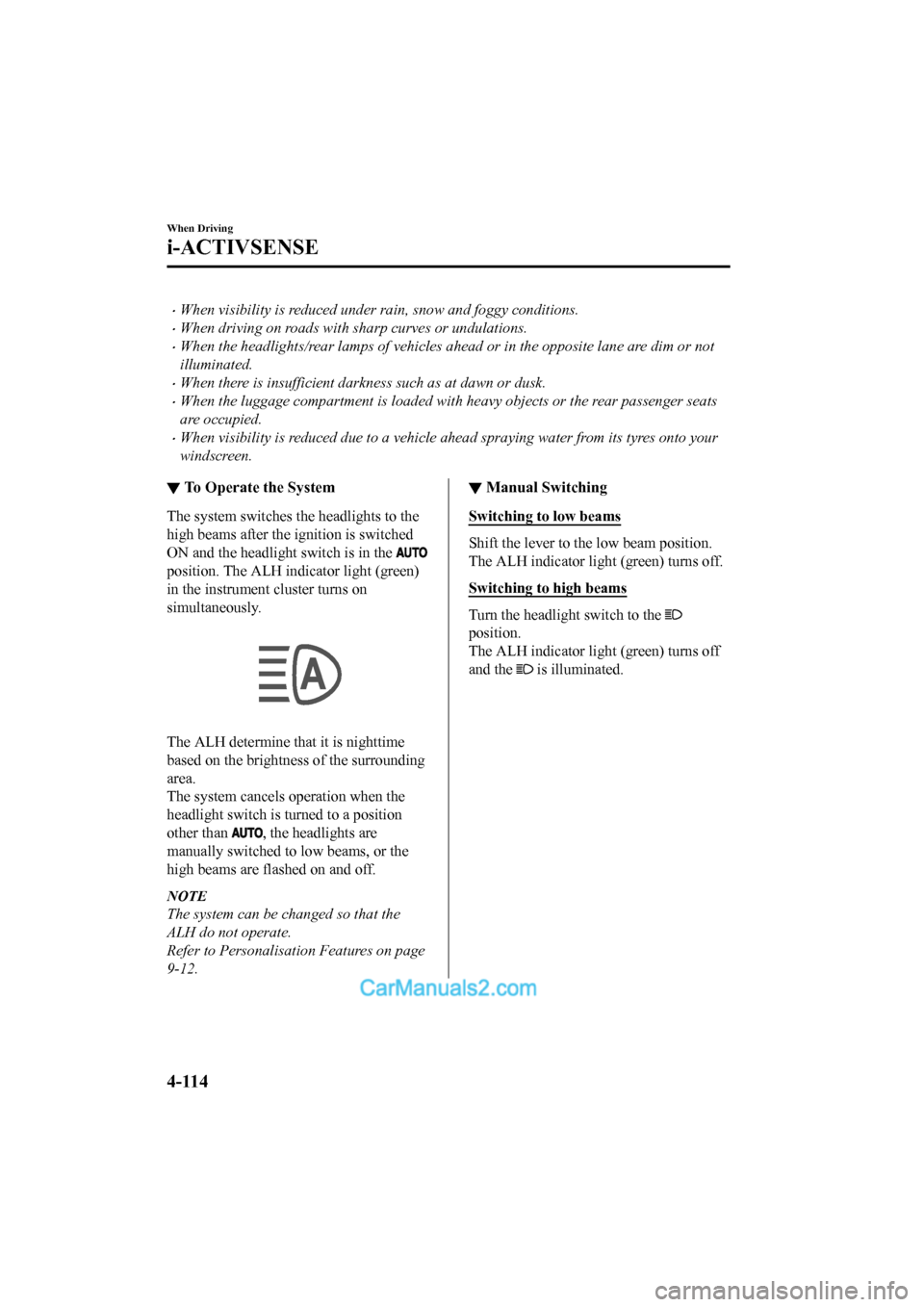
â¢When visibility is reduced under rain, snow and foggy conditions.
â¢When driving on roads with sharp curves or undulations.
â¢When the headlights/rear lamps of vehicles ahead or in the opposite lane are dim or not
illuminated.
â¢When there is insufficient darkness such as at dawn or dusk.
â¢When the luggage compartment is loaded with heavy objects or the rear passenger seats
are occupied.
â¢When visibility is reduced due to a vehicle ahead spraying water from its tyres onto your
windscreen.
â¼ To Operate the System
The system switches the headlights to the
high beams after the ignition is switched
ON and the headlight
switch is in the
position. The ALH indicator light (green)
in the instrument cluster turns on
simultaneously.
The ALH determine th at it is nighttime
based on the brightness of the surrounding
area.
The system cancels operation when the
headlight switch is turned to a position
other than
, the headlights are
manually switched to low beams, or the
high beams are flashed on and off.
NOTE
The system can be changed so that the
ALH do not operate.
Refer to Personalisation Features on page
9-12.
â¼ Manual Switching
Switching to low beams
Shift the lever to t
he low beam position.
The ALH indicator light (green) turns off.
Switching to high beams
Turn the headlight switch to the
position.
The ALH indicator light (green) turns off
and the
is illuminated.
When Driving
i-ACTIVSENSE
4-114
2017-6-7 7:51:19 Form No. CX-5 8FY4-EE-17E+L_Edition2
Page 280 of 772
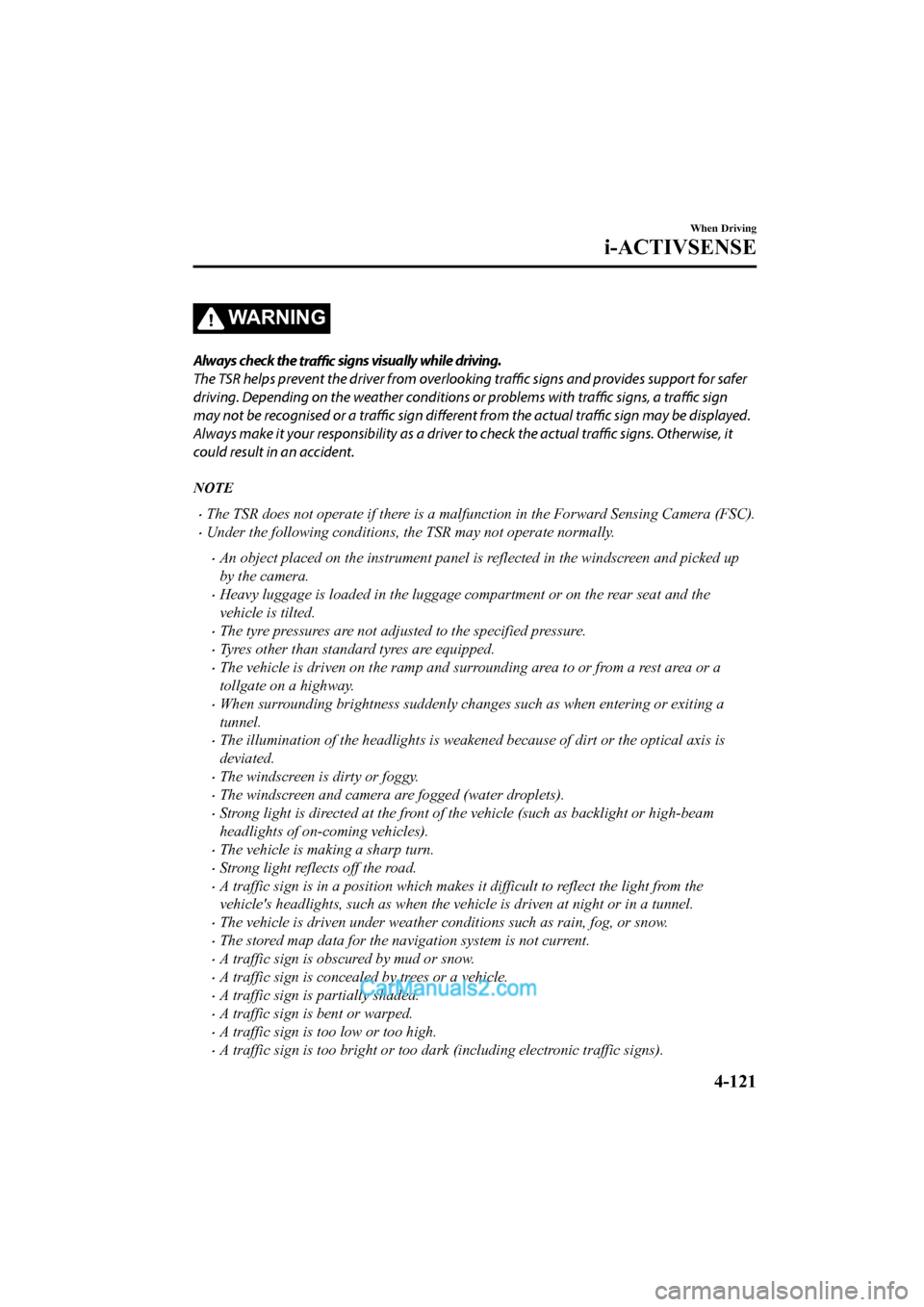
WA R N I N G
Always check the traffic signs visually while driving.
The TSR helps prevent the driver from overlookin g traffic signs and provides support for safer
driving. Depending on the weath er conditions or problems with
traffic signs, a
traffic sign
may not be recognised or a traffic sign different from the actual traffic sign may be displayed.
Always make it your responsibility as a driver to check the actual
traffic signs. Otherwise, it
could result in an accident.
NOTE
â¢The TSR does not operate if there is a malf unction in the Forward Sensing Camera (FSC).
â¢Under the following conditions, the TSR may not operate normally.
â¢An object placed on the instrument panel is reflected in the windscreen and picked up
by the camera.
â¢Heavy luggage is loaded in the luggage compartment or on the rear seat and the
vehicle is tilted.
â¢The tyre pressures are not adjusted to the specified pressure.
â¢Tyres other than standard tyres are equipped.
â¢The vehicle is driven on the ramp and surrounding area to or from a rest area or a
tollgate on a highway.
â¢When surrounding brightness suddenly changes such as when entering or exiting a
tunnel.
â¢The illumination of the headlights is weakened because of dirt or the optical axis is
deviated.
â¢The windscreen is dirty or foggy.
â¢The windscreen and camera are fogged (water droplets).
â¢Strong light is directed at the front of the vehicle (such as backlight or high-beam
headlights of on-coming vehicles).
â¢The vehicle is making a sharp turn.
â¢Strong light reflects off the road.
â¢A traffic sign is in a position which makes it difficult to reflect the light from the
vehicle's headlights, such as when the vehicle is driven at night or in a tunnel.
â¢The vehicle is driven under weather conditions such as rain, fog, or snow.
â¢The stored map data for the navigation system is not current.
â¢A traffic sign is obscured by mud or snow.
â¢A traffic sign is concealed by trees or a vehicle.
â¢A traffic sign is partially shaded.
â¢A traffic sign is bent or warped.
â¢A traffic sign is too low or too high.
â¢A traffic sign is too bright or too dark (including electronic traffic signs).
When Driving
i-ACTIVSENSE
4-121
2017-6-7 7:51:19 Form No. CX-5 8FY4-EE-17E+L_Edition2
Page 324 of 772
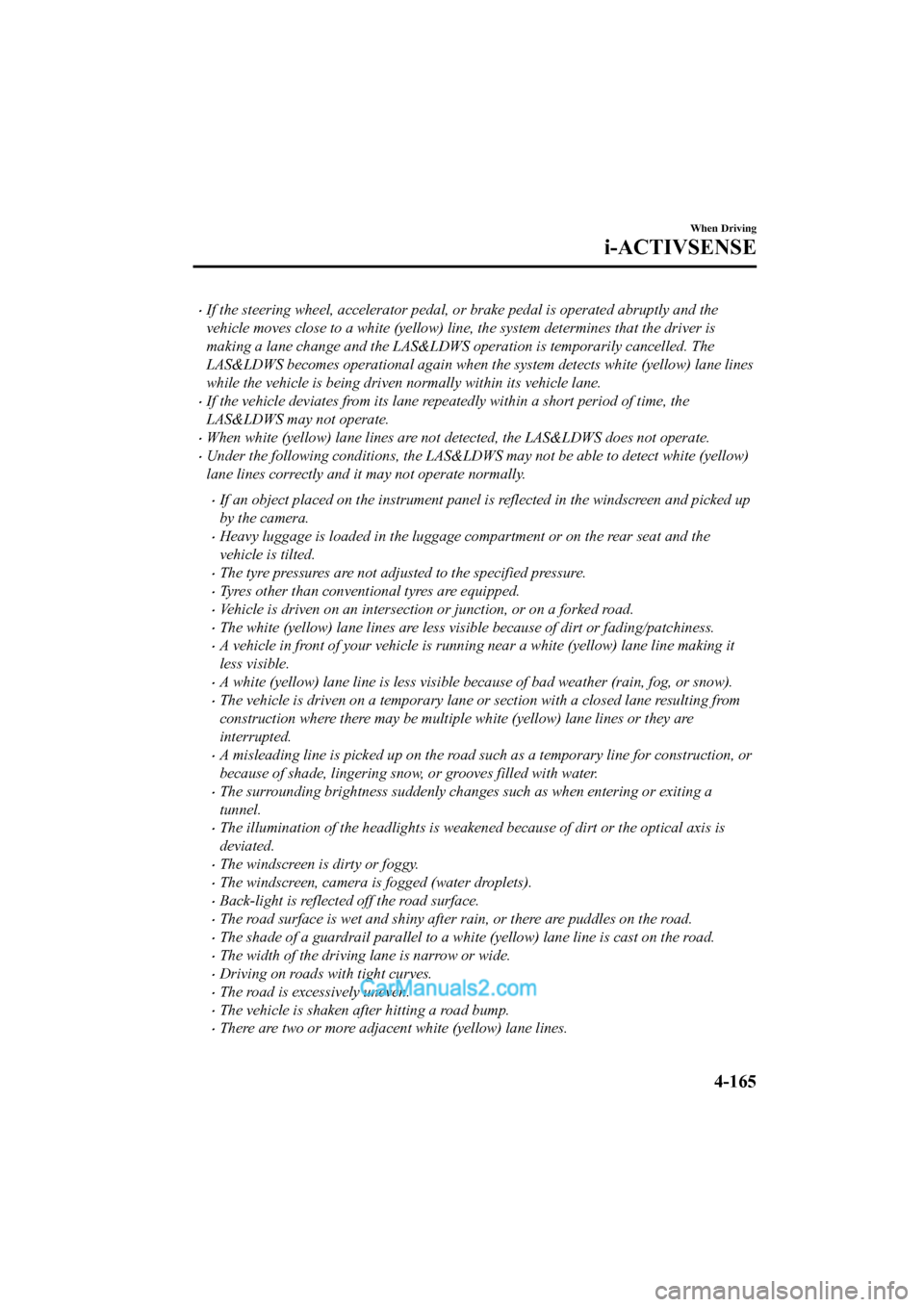
â¢If the steering wheel, accelerator pedal, or brake pedal is operated abruptly and the
vehicle moves close to a white (yellow) line, the system determines that the driver is
making a lane change and the LAS&LDWS operation is temporarily cancelled. The
LAS&LDWS becomes operational again when the system detects white (yellow) lane lines
while the vehicle is being driven normally within its vehicle lane.
â¢If the vehicle deviates from its lane repeatedly within a short period of time, the
LAS&LDWS may not operate.
â¢When white (yellow) lane lines are not detected, the LAS&LDWS does not operate.
â¢Under the following conditions, the LAS&LDWS may not be able to detect white (yellow)
lane lines correctly and it may not operate normally.
â¢If an object placed on the instrument panel is reflected in the windscreen and picked up
by the camera.
â¢Heavy luggage is loaded in the luggage compartment or on the rear seat and the
vehicle is tilted.
â¢The tyre pressures are not adjusted to the specified pressure.
â¢Tyres other than conventional tyres are equipped.
â¢Vehicle is driven on an intersection or junction, or on a forked road.
â¢The white (yellow) lane lines are less visi ble because of dirt or fading/patchiness.
â¢A vehicle in front of your vehicle is running near a white (yellow) lane line making it
less visible.
â¢A white (yellow) lane line is less visible because of bad weather (rain, fog, or snow).
â¢The vehicle is driven on a temporary lane or section with a closed lane resulting from
construction where there may be multiple wh ite (yellow) lane lines or they are
interrupted.
â¢A misleading line is picked up on the road su ch as a temporary line for construction, or
because of shade, lingering snow, or grooves filled with water.
â¢The surrounding brightness suddenly changes such as when entering or exiting a
tunnel.
â¢The illumination of the headlights is weakened because of dirt or the optical axis is
deviated.
â¢The windscreen is dirty or foggy.
â¢The windscreen, camera is fogged (water droplets).
â¢Back-light is reflected off the road surface.
â¢The road surface is wet and shiny after rain, or there are puddles on the road.
â¢The shade of a guardrail parallel to a white (yellow) lane line is cast on the road.
â¢The width of the driving lane is narrow or wide.
â¢Driving on roads with tight curves.
â¢The road is excessively uneven.
â¢The vehicle is shaken after hitting a road bump.
â¢There are two or more adjacent white (yellow) lane lines.
When Driving
i-ACTIVSENSE
4-165
2017-6-7 7:51:19 Form No. CX-5 8FY4-EE-17E+L_Edition2
Page 355 of 772
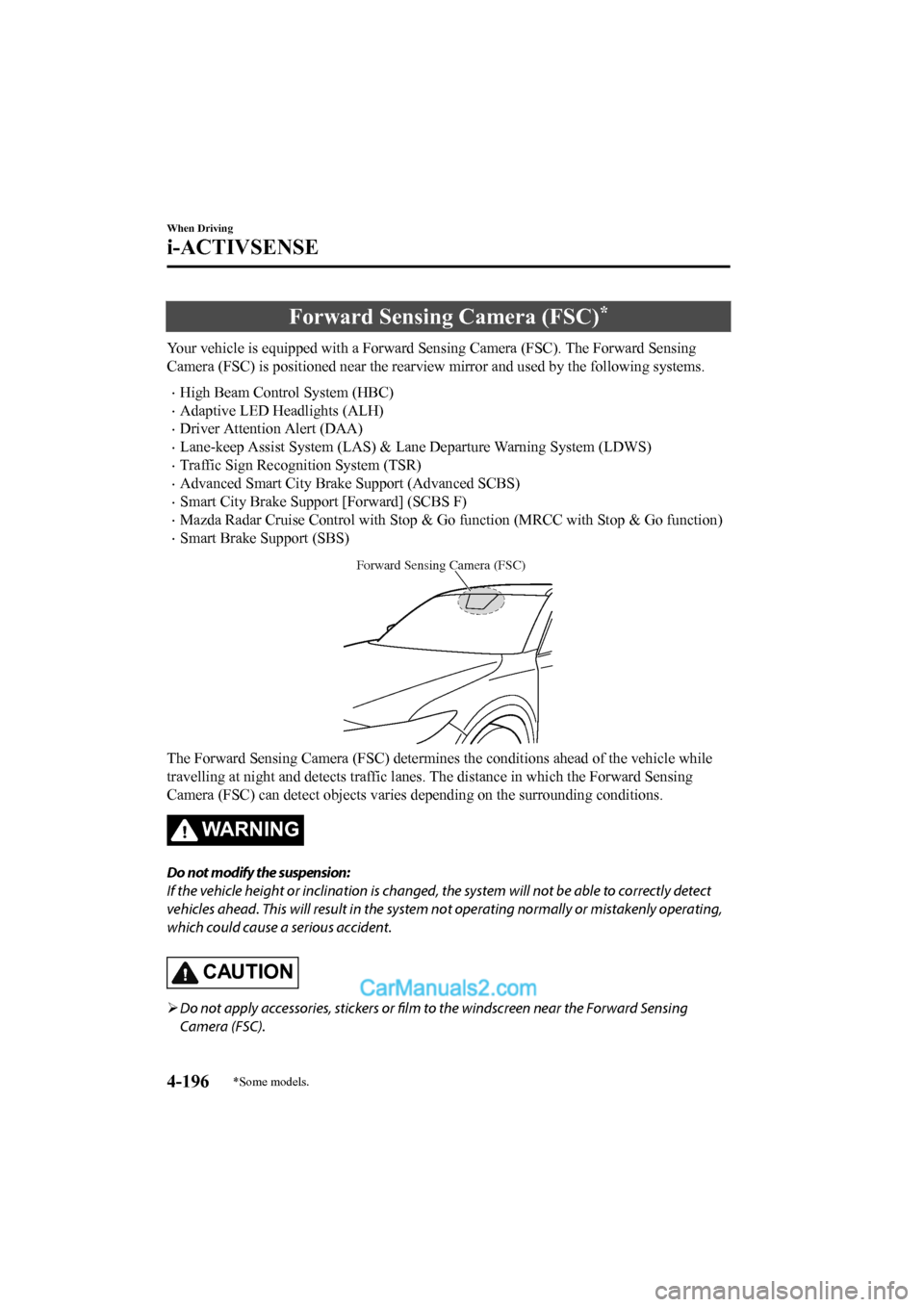
Forward Sensing Camera (FSC)*
Your vehicle is equipped with a Forward Sensing Camera (FSC). The Forward Sensing
Camera (FSC) is positioned near t he rearview mirror and used by the following systems.
â¢High Beam Control System (HBC)
â¢Adaptive LED Headlights (ALH)
â¢Driver Attention Alert (DAA)
â¢Lane-keep Assist System (LAS) & Lane Departure Warning System ( LDWS)
â¢Traffic Sign Recognition System (TSR)
â¢Advanced Smart City Brake Support (Advanced SCBS)
â¢Smart City Brake Support [Forward] (SCBS F)
â¢Mazda Radar Cruise Control with S top & Go function (MRCC with Stop & Go function)
â¢Smart Brake Support (SBS)
Forward Sensing Camera (FSC)
The Forward Sensing Camera (FSC) determines the conditions ahea d of the vehicle while
travelling at night and detects traffic lanes. The distance in which the Forward Sensing
Camera (FSC) can detect objects v aries depending on the surrounding conditions.
WA R N I N G
Do not modify the suspension:
If the vehicle height or inclination is changed, the system will not be able to correctly detect
vehicles ahead. This will result in the system not operating normally or mistakenly operating,
which could cause a serious accident.
CAUTION
ï Do not apply accessories, stickers or film to the windscreen near the Forward Sensing
Camera (FSC).
When Driving
i-ACTIVSENSE
4-196*Some models.
2017-6-7 7:51:19 Form No. CX-5 8FY4-EE-17E+L_Edition2
Page 356 of 772

If the area in front of the Forward Sensing Camera (FSC) lens is obstructed, it will cause the
system to not operate correctly. Consequently, each system may not operate normally
which could lead to an unexpected accident.
ï Do not disassemble or modify th e Forward Sensing Camera (FSC).
Disassembly or modification of the Forward Sensing Camera
(FSC) will cause a malfunction
or mistaken operation. Consequently, each sy stem may not operate normally which could
lead to an unexpected accident.
ï Heed the following cautions to assure the co rrect operation of the Forward Sensing Camera
(FSC).
ï Be careful not to scratch the Forward Sensing Camera (FSC) lens or allow it to get dirty.
ï Do not remove the Forward Sensing Camera (FSC) cover.
ï Do not place objects on the inst rument panel which reflect light.
ï Always keep the windscreen glass around the camera clean by removing dirt or fogging.
Use the windscreen defroster to remove fogging on the windscreen.
ï Consult an expert repairer, we recommend an Authorised Mazda Repairer regarding
cleaning the interior side of the windscre en around the Forward Sensing Camera (FSC).
ï Consult an expert repairer, we recommend an Authorised Mazda Repairer before
performing repairs around the Forward Sensing Camera (FSC).
ï The Forward Sensing Camera (FSC) is installed to the windscreen. Consult an expert
repairer, we recommend an Authorised Ma zda Repairer for windscreen repair and
replacement.
ï When cleaning the windscreen, do not a llow glass cleaners or similar cleaning
fluids to
get on the Forward Sensing Camera (FSC) le ns. In addition, do not touch the Forward
Sensing Camera (FSC) lens.
ï When performing repairs around the rearvi ew mirror, consult an expert repairer, we
recommend an Authorised Mazda Repairer.
ï Consult an expert repairer, we recommend an Authorised Mazda Repairer regarding
cleaning of the camera lens.
ï Do not hit or apply strong force to the Forward Sensing Camera (FSC) or the area around
it. If the Forward Sensing Camera (FSC) is severely hit or if there are cracks or damage
caused by flying gravel or debris in the area around it, stop using the following systems
and consult an expert repairer, we rec ommend an Authorised Mazda Repairer.
ï High Beam Control System (HBC)
ï Adaptive LED Headlights (ALH)
ï Driver Attention Alert (DAA)
ï Lane-keep Assist System (LAS) & Lane Departure Warning System (LDWS)
ï Traffic Sign Recognition System (TSR)
ï Advanced Smart City Brake Support (Advanced SCBS)
ï Smart City Brake Support [Forward] (SCBS F)
ï Mazda Radar Cruise Control with Stop & Go function (MRCC with Stop & Go function)
When Driving
i-ACTIVSENSE
4-197
2017-6-7 7:51:19 Form No. CX-5 8FY4-EE-17E+L_Edition2